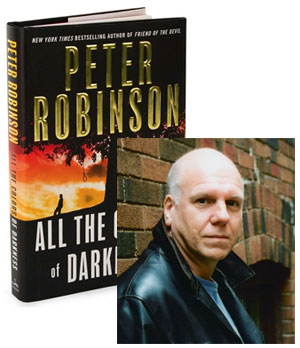Lady Jane’s: As Featured in the New York Post!
NY Post reporter Mandy Stadtmiller came to Lady Jane’s Salon, the romance novel reading series I help run as a monthly fundraiser for Share the Love, and the interviews she got there became part of an article about how romance thrives even in this publishing climate. Another result of the evening: This video, in which I make a brief appearance along with Sarah Wendell of Smart Bitches, Trashy Books, and Lady Jane’s co-creators Maya Rodale and Leanna Renee Hieber. (I believe you will see an ad first; can’t be helped. Oh, and apologies to RSS readers who aren’t seeing it all and will have to click through.)
Maya’s going to be reading from her second novel, The Rogue and the Rival, at the next Lady Jane’s Salon, on April 6, and I hope you’ll come by Madame X (94 W. Houston St) at 7 p.m. to see for yourself how great the series is.
12 March 2009 | lady jane's salon |
Peter Robinson: Twenty-Plus Years with Inspector Banks
 Peter Robinson came to North America in the 1970s, after he saw a flyer advertising a master’s program in creative writing at the University of Windsor. He didn’t get accepted into that program, but they did let him in for an English literature degree, and when Joyce Carol Oates (who was running the creative writing program) heard some of his poems, she brought him into the fold. He remained in Canada after obtaining his Ph.D., but found that poetry was getting harder to write and publish—and, he noticed, his poems were taking on more narrative elements. So he began writing a mystery, set in his native Yorkshire. “I hadn’t been in Canada very long,” he recalled during a recent interview. “I was a little homesick sometimes, and I was very fond of British and European detective novels—at the time, it seemed obvious to me.”
Peter Robinson came to North America in the 1970s, after he saw a flyer advertising a master’s program in creative writing at the University of Windsor. He didn’t get accepted into that program, but they did let him in for an English literature degree, and when Joyce Carol Oates (who was running the creative writing program) heard some of his poems, she brought him into the fold. He remained in Canada after obtaining his Ph.D., but found that poetry was getting harder to write and publish—and, he noticed, his poems were taking on more narrative elements. So he began writing a mystery, set in his native Yorkshire. “I hadn’t been in Canada very long,” he recalled during a recent interview. “I was a little homesick sometimes, and I was very fond of British and European detective novels—at the time, it seemed obvious to me.”
The novel that resulted, Gallows View, became the first in a series of mysteries starring police inspector Alan Banks that spans 18 volumes over a little more than two decades. “I would’ve always thought that ten years later, I’d still be writng and publishing, but I had no idea I’d be dealing with the same character,” he admitted as I chatted with him about the latest in the series, All the Colors of Darkness. Banks ages almost in real time, as do the other characters around him: “They’ve grown older, like everybody else,” Robinson reflected. “Banks has become more isolated and introspective. He’s been affected by the things he’s had to deal with in his job, haunted by certain cases. But he continues with remarkable fortitude. I don’t know how he does it.”
“For a long time, I thought Banks was a happily married man—but I think readers may have realized there was something wrong with his marriage before I did. It was his wife that had an affair, and he didn’t see it coming. I didn’t see it coming.” Banks’s subsequent reclusiveness has also been a surprise to Robinson, but that reaction is consistent with the way he writes: “It’s always an exploration, never something I know going in.” That applies to the crimes that ground his narratives as well; despite the intricate plot of All the Colors of Darkness, Robinson insists that all he had when he started writing was the discovery of the first body, and everything that followed came from asking himself why it had happened.
I don’t want to give too much away about the plot, but it’s safe to say the investigation takes Banks in some new directions, outside the routine police procedural, and what he’s kicked up may play a part in future books. “A certain degree of paranoia has entered his soul,” Robinson conceded. “He’ll always be looking over his shoulder. He has to be careful from now on. Of course, he won’t be.”
9 March 2009 | interviews |

 Our Endless and Proper Work is my new book with Belt Publishing about starting (and sticking to) a productive writing practice.
Our Endless and Proper Work is my new book with Belt Publishing about starting (and sticking to) a productive writing practice. 
